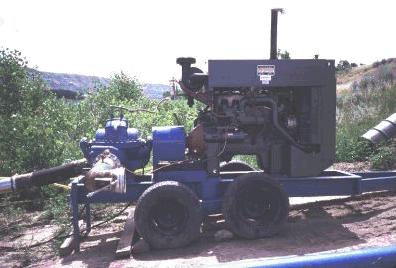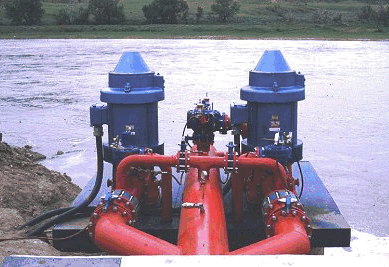| | An individual wishing to develop new irrigation projects can apply to obtain water from one of Alberta's 13 irrigation districts or to Alberta Environment if the water source is not from an irrigation district. Each irrigation district holds a license, issued by Alberta Environment, which permits the district to divert a certain volume of water from a watercourse into district owned conveyance and storage systems. The irrigator who has obtained water from a district is charged a one-time "capital assets charge" by the irrigation district after the "irrigation acres" have been added to the assessment roll of the district. The fee varies among districts. In addition, the irrigator is assessed an annual water rate for the irrigation acres to cover operation and maintenance costs incurred by the district.
An irrigation project that does not obtain water from an irrigation district is referred to as a private irrigation development project. The private irrigation developer holds the water diversion license similar to an irrigation district. A private irrigator who holds a water license issued by Alberta Environment is not charged a capital assets charge or annual water rate. However, a one-time license fee may be applicable, depending on the volume of water diverted.
Procedure to Obtain Water From an Irrigation District for New Irrigation Acres
The irrigation district must be contacted to determine whether water for new irrigation acres is available for the proposed irrigation project and whether the district can service the parcel. "New irrigation acres" means the acres in a parcel that have not been on the assessment roll of an irrigation district as "irrigated acres".
If new acres are being considered for irrigation, the district will ask you to obtain and submit an application to the district containing the legal land description, type of irrigation system being proposed, a drawing of the parcel with the proposed irrigation system, and total proposed irrigated area. The district will decide if it is feasible to serve the acres requested based on this preliminary information. If the district agrees with the proposed development, a Level II land classification for irrigation report must be completed to determine whether or not the land is suitable for irrigation. A Level II land classification report is mandatory, according to the Irrigation Districts Act, before new irrigation acres can be added to the assessment roll of an irrigation district. The classification must be completed by an accredited land classification-consulting agrologist, according to the most recent "Standards for the Classification of Land For Irrigation in the Province of Alberta". A list of consulting agrologists can be obtained from the Alberta Agriculture and Food (AF) website, irrigation districts, or the nearest AF, Technology & Innovation Branch office.
The irrigator submits the completed Level II land classification report to the irrigation district. District staff review and prioritize the proposed project. The proposal is presented at the next irrigation district board meeting for final decision on whether the parcel will be added to the assessment roll of the district.
Procedure to Obtain Water for Private Irrigation Development
Inquire at your local Alberta Environment (AENV) office whether or not water allocations are being issued for irrigation from the water source being considered. See list below for location of Alberta Environment water management offices. If new allocations are being granted, an application under the Water Act for approvals and/or licenses is required by Alberta Environment. Refer to Alberta Environment's website for the application form.
- Select: Water Act Application> PDF or DOC
- Consult the Water Act Fact Sheet for instructions and necessary documentation required for the completed application.
- Select: Approvals and Licenses (PDF)
Remember, the more complete your information is, the quicker AENV personnel can assess your project and answer your request!
A Level II land classification for irrigation report must be completed to determine whether the land is suitable for irrigation. The classification must be completed by an accredited land classification-consulting agrologist, according to the most recent "Standards for the Classification of Land For Irrigation in the Province of Alberta". A list of consulting agrologists can be obtained from the AF website, irrigation districts, or the nearest AF, Technology & Innovation Branch office.
The completed Level II land classification report is required input to an agricultural feasibility report.
An agricultural feasibility report is required to obtain a water license according to the Water Act and is described in the "Guideline for Preparing Agricultural Feasibility Reports for Irrigation Projects" (Alberta Environment, September 2002). Contact the nearest AF, Technology & Innovation Branch office (listed below) for help with the process of preparing agricultural feasibility reports.
Portable pump site with intake into river (no river bed or bank disturbance)
Withdrawals are generally made from a water body, adjacent to or a short distance from the land being irrigated by using a portable pump location. A portable pump site is defined as one that can be moved along the bank of the water body from one pumping level to another. Usually, only the intake pipe is extended into the water body.
Alberta Environment, Alberta Sustainable Resource Development (Public Lands Division) and Fisheries and Oceans Canada (DFO) will often have restrictions on the river to prevent disturbance of the riverbed or bank.

A typical portable pump site.
Construction or disturbance of bank or bed of river for pump site or intake.
Additional authorizations may be required where withdrawals from a water body are made by using a fixed pump location and river bed and/or bank construction is needed.

A typical fixed pump site.
Alberta Environment Water Approvals
Alberta Environment requires the following information to assess your project.
- Complete application under the Water Act (Form GA1 (2002)).
- Written consent from the landowner, if the applicant is not the registered owner.
- A general location and key plan.
- An agricultural feasibility report.
NOTE: Additional information may be required and in such cases, AENV staff will contact the applicant.
In addition to the requirements listed for Alberta Environment, Alberta Sustainable Resource Development (Public Lands Division) and the Department of Fisheries and Oceans will need to be notified and their requirements must be met as follows.
Alberta Sustainable Resource Development - Public Lands Division
A License of Occupation (LOC) is required under the Public Lands Act to build any structures that could have an impact on the bed and shore of a water body. For more information on Crown-owned bed and shores and any necessary approvals, contact the Alberta Sustainable Resource Development Information office. Contact information is listed at the end of this document.
Fisheries and Oceans Canada
Fisheries and Oceans Canada (DFO) needs the documentation/information listed below to assess your project.
- Description of your project, how works or undertaking will be carried out, any temporary structures necessary to complete the project, a construction schedule, and confirmation of compliance with local by-laws.
- Property ownership status. If you are not the owner, attach a signed letter of permission from the owner.
- Map or chart showing location of project.
- A sketch or drawing of your project, including side and top view, and dimensions of the project.
- Survey plan or sketch with dimensions indicating the location of existing buildings, shoreline structures, property lines, adjacent properties (include names), and low and high water marks.
- Current photographs of the proposed project site taken from a variety of perspectives, displaying the shoreline, the shoreline vegetation, and the watercourse bottom (top view).
- List of any materials that will be used in the proposed project.
- List of any equipment that will be used during the project.
- Description of fish habitat that may be affected by the project (migratory route, spawning and rearing areas, fish present at the site, etc.).
Additional information may be required in some cases. DFO personnel will contact you after reviewing your request. Remember, the more complete your information is, the quicker DFO personnel can assess your project and answer your request!
Fisheries and Oceans Canada - Canadian Coast Guard
The Navigable Waters Protection Act stipulates that an application must be made to the Minister of Fisheries and Oceans Canada before starting any construction below the high water mark of a navigable body of water. "Navigable waters" includes any body of water, coastal or inland, in its natural state or man-made, and capable of being navigated by floating vessels of any description for the purpose of transportation, recreation or commerce.
Applicants are encouraged to contact the Canadian Coast Guard early in the process to determine regulatory requirements. Application for a Navigable Waters Approval is normally made by letter, which should describe the nature and extent of the work, its location, and the anticipated time of construction. The letter should be accompanied by 11 copies of the plans of the proposed work, with sufficient detail to show the extent of the project below the high water mark.
Contact the provincial office administering Navigable Waters Protection Act. In Alberta, contact the office of Fisheries and Oceans Canada, Edmonton to obtain a Navigable Waters Works Application form. Complete the form and submit to same for approval.
To ensure that the public right of navigation is protected, a proponent may be required to publicly advertise any intentions to construct works in navigable waters prior to the approval of any plans. Works of a minor nature may be granted an approval in the form of an "exemption" from the Act.
Contacts:
Alberta Agriculture and Rural Development
Lethbridge Office
Technology & Innovation Branch
Alberta Agriculture and Rural Development
Agriculture Center
100, 5401 - 1st Ave S
Lethbridge, AB T1J 4V6
Phone: 403-381-5140
Bow Island Office
Technology & Innovation Branch
Alberta Agriculture and Food
Provincial Building
802 - 6th St East
Bow Island, AB T0K 0G0
Phone: 403-545-2231
Brooks Office
Technology & Innovation Branch
Alberta Agriculture and Food
Crop Diversification Centre South
301 Horticultural Station Road East
Brooks, AB T1R 1E6
Phone: 403-362-1347
Alberta Environment
Calgary Office
Alberta Environment Water Management
2938 - 11 St. NE
Calgary, AB T2E 7L7
Phone: 403-297-6582
Lethbridge Office
Alberta Environment Water Management
2nd Floor, Provincial Building
200 - 5th Ave. South
Lethbridge, AB T1J 4L1
Phone: 403-382-4254
Red Deer Office
Alberta Environment Water Management
304 Provincial Building
4920 - 51 Street
Red Deer, AB T4N 6K8
Phone: 403-340-7052
Edmonton Office
Alberta Environment Water Management
Twin Atria Building
111, 4999 - 98 Ave
Edmonton, AB T6B 2X3
Phone: 780-427-5296
Spruce Grove Office
250 Diamond Avenue
Spruce Grove, AB T7X 4G7
Phone: 780-960-8600
Peace River Office
Alberta Environment Water Management
Provincial Building
9621 - 96 Ave
Peace River, AB T8S 1T4
Phone: 780-624-6167
Alberta Sustainable Resource Development
Information Centre
Main Floor, 9920 108 Street
Edmonton, AB
T5K 2M4
Phone: 780-944-0313
FAX: 780-427-4407
Email: env.infocent@gov.ab.ca
Fisheries and Oceans Canada
Calgary Office
Fisheries & Oceans Canada
Calgary District
7646 8th Street NE
Calgary AB T2E 8X4
Phone: 403-292-5160
Edmonton Office
Fisheries & Oceans Canada
Edmonton District
4253 97th Street
Edmonton AB T6E 5Y7
Phone: 780-495-4220
Lethbridge Office
Fisheries & Oceans Canada
Lethbridge District
204-704 4th Avenue S
Lethbridge AB T1J 0N8
Phone: 403-394-2920
Peace River Office
Fisheries & Oceans Canada
Peace River District
9001 94th Street
Peace River AB T8S 1G9
Phone: 780-618-3220
This fact sheet on Regulatory Requirements for New Irrigation Projects in Alberta is one of a series of information bulletins on agriculture and resource management produced by the Technology & Irrigation Branch, Alberta Agriculture and Food.
IB001-2004 |
|